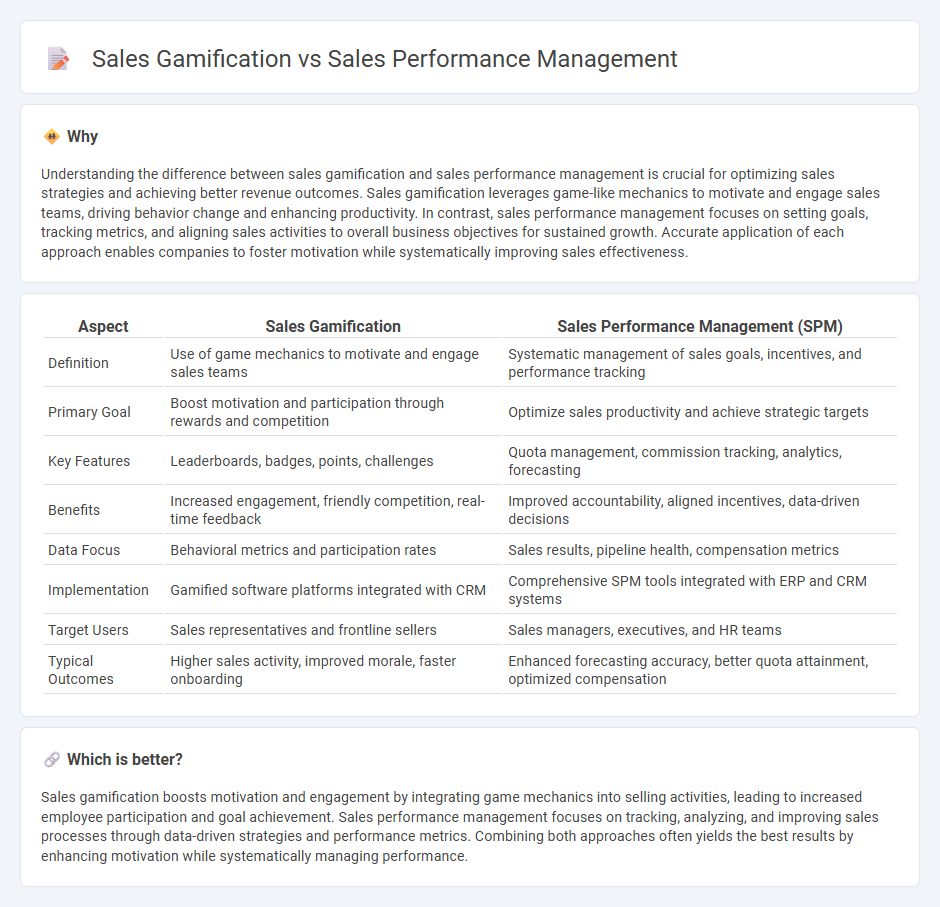
Sales gamification leverages game design elements such as points, badges, and leaderboards to motivate and engage sales teams, driving higher activity and goal achievement. Sales performance management focuses on strategic processes like goal setting, performance analytics, and coaching to optimize sales productivity and outcomes. Explore how integrating gamification with performance management can transform your sales strategy for measurable success.
Why it is important
Understanding the difference between sales gamification and sales performance management is crucial for optimizing sales strategies and achieving better revenue outcomes. Sales gamification leverages game-like mechanics to motivate and engage sales teams, driving behavior change and enhancing productivity. In contrast, sales performance management focuses on setting goals, tracking metrics, and aligning sales activities to overall business objectives for sustained growth. Accurate application of each approach enables companies to foster motivation while systematically improving sales effectiveness.
Comparison Table
| Aspect | Sales Gamification | Sales Performance Management (SPM) |
|---|---|---|
| Definition | Use of game mechanics to motivate and engage sales teams | Systematic management of sales goals, incentives, and performance tracking |
| Primary Goal | Boost motivation and participation through rewards and competition | Optimize sales productivity and achieve strategic targets |
| Key Features | Leaderboards, badges, points, challenges | Quota management, commission tracking, analytics, forecasting |
| Benefits | Increased engagement, friendly competition, real-time feedback | Improved accountability, aligned incentives, data-driven decisions |
| Data Focus | Behavioral metrics and participation rates | Sales results, pipeline health, compensation metrics |
| Implementation | Gamified software platforms integrated with CRM | Comprehensive SPM tools integrated with ERP and CRM systems |
| Target Users | Sales representatives and frontline sellers | Sales managers, executives, and HR teams |
| Typical Outcomes | Higher sales activity, improved morale, faster onboarding | Enhanced forecasting accuracy, better quota attainment, optimized compensation |
Which is better?
Sales gamification boosts motivation and engagement by integrating game mechanics into selling activities, leading to increased employee participation and goal achievement. Sales performance management focuses on tracking, analyzing, and improving sales processes through data-driven strategies and performance metrics. Combining both approaches often yields the best results by enhancing motivation while systematically managing performance.
Connection
Sales gamification leverages game mechanics to motivate and engage sales teams, enhancing productivity and driving goal achievement. Sales performance management (SPM) uses data analytics and performance metrics to monitor, evaluate, and optimize sales activities. Integrating gamification within SPM frameworks fosters a competitive environment that improves sales outcomes by aligning individual incentives with organizational targets.
Key Terms
**Sales Performance Management:**
Sales Performance Management (SPM) involves the strategic processes and technologies that optimize sales team productivity by setting goals, tracking performance metrics, and providing data-driven insights for compensation and training. It encompasses quota management, incentive compensation, and sales analytics to ensure alignment between sales objectives and business outcomes. Explore how SPM can transform your sales strategy for measurable growth and efficiency.
Quota Attainment
Sales performance management systematically tracks and optimizes quota attainment through goal setting, performance analytics, and incentive programs, ensuring sales teams meet targets efficiently. Sales gamification enhances quota attainment by incorporating game elements such as leaderboards, rewards, and challenges that boost motivation and engagement while maintaining focus on sales goals. Explore how integrating both strategies can maximize quota attainment and drive sustainable revenue growth.
Sales Analytics
Sales performance management (SPM) focuses on tracking, analyzing, and optimizing sales processes using advanced sales analytics to improve revenue forecasting, quota setting, and incentive compensation. Sales gamification leverages game mechanics and real-time analytics to boost motivation, engagement, and sales productivity by creating competitive environments and tracking performance metrics. Explore how integrating sales analytics within both approaches can drive smarter decision-making and enhanced sales outcomes.
Source and External Links
What Is Sales Performance Management? Examples and Tips - Sales performance management (SPM) is a structured process that helps organizations track, manage, and improve sales team performance through planning, compensation, incentives, and quota management.
What Is Sales Performance Management (SPM)? A Guide for 2025 - Effective SPM involves setting clear metrics and goals, building tailored strategies, and continuously optimizing team structure and processes to drive better sales results.
What is Sales Performance Management (SPM)? - SPM systems use real-time tracking, benchmarking, and analytics to align sales activities with company objectives, enabling data-driven decisions and consistent revenue growth.
 dowidth.com
dowidth.com